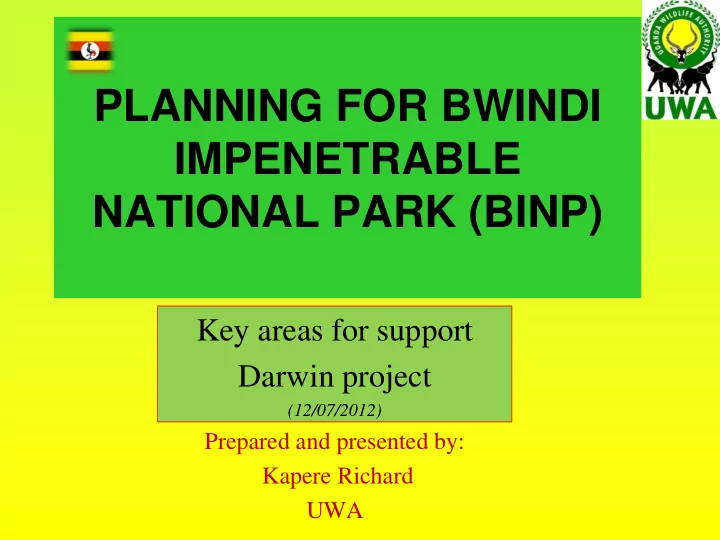

PLANNING FOR BWINDI IMPENETRABLE NATIONAL PARK (BINP) Key areas for support Darwin project (12/07/2012) Prepared and presented by: Kapere Richard UWA
LEVELS OF CONSERVATION PLANNING IN UWA General direction for UWA Strategic Plan Expires in 2012 Process to develop a new one (5years) (2013-2018) on-going Implemented partly through the GMPs at field level Protected Area level General Management Ecosystem management Implemented mainly through Plans (10years) AOPs Expire at different times A basis for activity Annual Operational prioritization Implemented annually Plans Basis for annual budgeting and expenditures
General Management Planning Steps 1. Baseline information gathering (adverts, libraries, etc) 2. Initiation meeting-Planning team selection (Internal) 3. Orientation of the planning team 4. Reconnaissance (Field survey/fact finding/appreciation of issues by planning team) 5. Consultations (Local level) 6. Proposals generation (Drafting the concept) 7. Presentation of concept to UWA Senior Management 8. Plan drafting 9. National and Regional consultations 10.Presentation of the draft plan to Top Management 11.Presentation of draft plan to stakeholders at local level 12.Developing M & E Framework 13.Presentation of draft to BoT for comments and approval 14.Editing, Printing and distribution
Planning for BINP-GMP 2013-2023) Old GMP 2001-2011 (Extended for 2years) Planning team(16members): Nature: Interdisciplinary BINP Field Composition: Multi-stakeholder team- selected staff Kanungu- DEO ITFC, IGCP Planning Unit- secretariat; Kampala Kisoro- Kabale- NGO DNRO forum
STATUS 1. Baseline information gathering (adverts, libraries, etc) 2. Initiation meeting-Planning team selection (Internal) 3. Orientation of the planning team 4. Reconnaissance (Field survey/fact finding) 5. Consultations (Local level) 6. Proposals generation (Drafting the concept) 7. Presentation of concept to UWA Senior Management 8. Plan drafting 9. National and Regional consultations 10.Presentation of the draft plan to Top Management 11.Presentation of draft plan to stakeholders at local level 12.Developing M & E Framework 13.Presentation of draft to BoT for comments and approval 14.Editing, Printing and distribution
Major proposals resulting from the process Management zones (1km from boundary for Resource use) N W E BINP Management Zones S KEY Roads 0 All Weather, Loose Surface Dry W eather, Loose Surface Motorable Track Footpath Patrol / Research Trail Public Footpath in Park Tourist Trail Defunct Trail Boundary Small rivers Seasonal rivers Big rivers Wilderness zone Resource use zone Tourism zone 5 0 5 10 Kilometers
Major proposals resulting from the process Management Purpose for BINP To conserve BINP for its exceptional biodiversity, such as the critically endangered Mountain Gorilla and other endemic species and its fragile ecosystem, that is also an important water catchment area among other ecosystem services, for the benefit of the local, national and the global community. Conservation Values : the reason the area was designated . They should therefore receive the highest protection if the area is to maintain its designated status. • Pleistocene refugium (A biodiversity hot spot including Mountain Gorilla and endemic rare species) • Water catchment and retention • Diverse fauna and flora • Habitat for endangered species including Mountain Gorillas • Esthetic values (Stunning scenic beauty) • Climate stabilization and a carbon sink • Cultural heritage for indigenous people & A world heritage site
Plan Implementation Proposed Major Actions for support Based on the proposals resulting from the planning process Six priority areas 1. Research on changing Gorilla home ranges/Problem Animal management/buffer zones taking the Nkuringo scenario 2. Research to investigate the optimal level of gorilla groups that can be habituated without significantly impacting on the resource base negatively 3. Wildlife disease surveillance and management of disease outbreaks 4. Economic valuation of BINP as a basis for Payment of Ecosystem Services (PES) and willigness to pay by the partners 5. Evaluation of effectiveness of resource sharing programs 6. Social economic surveys/studies in relation to th e park
Continued……… Other priority areas 1. Identification and promotion of the multiplication (ex-situ) of forest resources outside the park 2. Lobbying for the improvement of tourism trunk roads and other access roads up to park boundary 3. Initiation and support of climate change related research within and outside the park. 4. Initiation of conservation incentives in addition to the existing revenue sharing/gorilla levy to the neighboring communities. 5. Conducting a feasibility study for Batwa cultural Tourism in BINP 6. Bio-diversity inventory for BINP. 7. Establishment of a voluntary climate change mitigation and adaptation fund (CMAF-BINP). 8. Promotion of conservation friendly land use practices out side the park
End Thank you Appeal: Management of Imperata cylindrica (Spear grass) as an invasive plant species in National Parks; A case study of Queen Elizabeth National Park-Uganda.
Recommend
More recommend